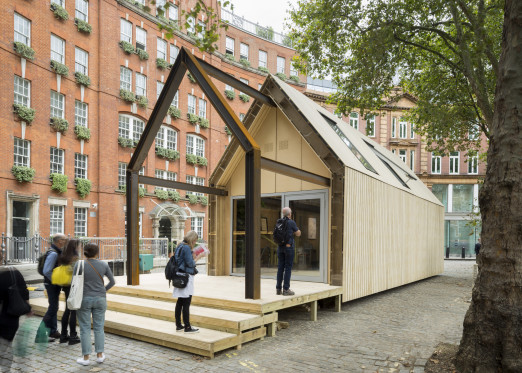The disposal of electronic consumer goods such as laptops and mobile phones results in 30 million tonnes of waste each year –15,000 tonnes is due to headphones. With acoustics design by Scheek Loudspeakers, the Gerrard Street leasable headphones reuse 85% of the materials and components. Modular design enables upgrades by updating single parts. This, combined with high-end design and specifications, means there is no need to manufacture an entirely new product.
Loop / Share
Headphones. Gerrard Street (Recycled components, Amsterdam, Netherlands, 2015)
Interview with founders, Tom Leenders, Dorus Galama and Yvette Koppert of Gerrard Street
Could you tell us a little bit about your professional background(s) and how you got interested in the Circular Economy?
Tom Leenders/Dorus Galama/Yvette Koppert: Tom and Dorus both studied Industrial Design at the TU Delft. They got interested in the Circular Economy during their master thesis internship, which was focused on a Circular Economy design project. Yvette has 3 years of Corporate Finance advisory experience and did her studies at the Erasmus University. With her natural curiosity towards business and sustainability, she developed a genuine interest in Circular Economy business models during these years.
How much were you influenced by your research and studies at Delft and Erasmus? How prominent is circular economy thinking in the design and business school?
TL/ DG/ YK: Both at the TU Delft and at Erasmus, Circular Economy thinking was not (yet) prominent.
Could you describe your process of developing the business model? How did you arrive at Headphones as your chosen product?
TL/ DG/ YK: In the beginning we tried to design a modular TV. However, this product did not seem to fit the modular and leasing concept we had in mind. As we all are music lovers and are frequent headphone users, we ourselves had the frustration of throwing away several headphones a year due to minor defects. During our market research we found that other people feel this pain as well. The combination of this customer pain and the Circular Economy vision led to the development of the current modular headphone.
What kind of market research did you do and what insights did you get?
TL/ DG/ YK: With focus groups we found out that most headphone users recognise the frustration that a simple cable breakage renders the product worthless. We found this poses a barrier for many people - who are willing to buy premium headphones - to spend hundreds of euros on such a vulnerable product. In addition, they feel uncertain about judging the quality or are hesitant about whether they would use the headphones enough to justify spending such a large amount of money. In short, these people perceive paying €250+ for headphones as a risk.
In order to validate market demand, we performed a test with a MVP (Minimal Viable Product). In short, we offered 127 people a retail headphone priced at €259 for €5 a month for one year – focusing on Dutch male music lovers between 20 and 30. With the test described above, we demonstrated a conversion of 35% within this segment.
(Modular design means, upgrades doesn't require disposing of headphones. Courtesy of Gerrard Street)
How would you describe the different mindsets of circular thinking/Design for the CE versus traditional linear thinking for the linear economy?
TL/ DG/ YK: CE design is fully focused on how to design for reuse and/or recycling in combination with designing a product that consumers will love. In contrast, the linear design thinking is only focused on designing a product that will sell.
What has been the most challenging part of the process?
TL/ DG/ YK: To validate a customer pain.
What has the reaction been so far?
TL/ DG/ YK: So far we have 600 paying customers and the reactions are very good! People love the sound quality and greatly appreciate our repair service.
Next steps?
TL/ DG/ YK: Improving our service to our current members, increasing our member base, developing a wireless model and eventually start with other consumer electronics as well.
For anyone interested in this field, what books or articles would you recommend to read?
TL/ DG/ YK: The End of Ownership – Thomas Rau (Documentary film)
Marketing and communication is one of the least remarked on aspects of circular economy products.
TL/ DG/ YK: Polar bears ain’t going to pay your bills – with our marketing communications we first focus on the customer pain we are trying to solve. To complete our narrative we tell about our vision and the circularity of our business that comes with it.
For more on Gerrard Street, click here



